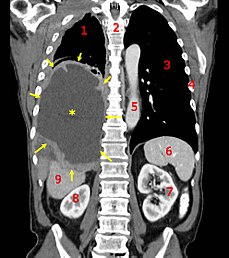Cancer /ˈkænsər/ (medical term: malignant neoplasm) is a class of diseases in which a cell, or a group of cells display uncontrolled growth (division beyond the normal limits), invasion (intrusion on and destruction of adjacent tissues), and sometimes metastasis (spread to other locations in the body via lymph or blood). These three malignant properties of cancers differentiate them from benign tumors, which are self-limited, and do not invade or metastasize. Most cancers form a tumor but some, like leukemia, do not. The branch of medicine concerned with the study, diagnosis, treatment, and prevention of cancer is oncology.
Cancer affects people at all ages with the risk for most types increasing with age.[1] It caused about 13% of all human deaths in 2007[2] (7.6 million).[3] Cancers are primarily an environmental disease with 90-95% of cases due to lifestyle and environmental factors and 5-10% due to genetics.[4] Common environmental factors leading to cancer death include: tobacco (25-30%) , diet and obesity (30-35%), infections (15-20%), radiation, stress, physical activity, environmental pollutants.[4] These environmental factors cause abnormalities in the genetic material of cells.[5]
Genetic abnormalities found in cancer typically affect two general classes of genes. Cancer-promoting oncogenes are typically activated in cancer cells, giving those cells new properties, such as hyperactive growth and division, protection against programmed cell death, loss of respect for normal tissue boundaries, and the ability to become established in diverse tissue environments. Tumor suppressor genes are then inactivated in cancer cells, resulting in the loss of normal functions in those cells, such as accurate DNA replication, control over the cell cycle, orientation and adhesion within tissues, and interaction with protective cells of the immune system.
Definitive diagnosis requires the histologic examination of a biopsy specimen, although the initial indication of malignancy can be symptomatic or radiographic imaging abnormalities. Most cancers can be treated and some forced into remission, depending on the specific type, location, and stage. Once diagnosed, cancer is usually treated with a combination of surgery, chemotherapy and radiotherapy. As research develops, treatments are becoming more specific for different varieties of cancer. There has been significant progress in the development of targeted therapy drugs that act specifically on detectable molecular abnormalities in certain tumors, and which minimize damage to normal cells. The prognosis of cancer patients is most influenced by the type of cancer, as well as the stage, or extent of the disease. In addition, histologic grading and the presence of specific molecular markers can also be useful in establishing prognosis, as well as in determining individual treatments.
| Cancer | |
|---|---|
| Classification and external resources | |
 A coronal CT scan showing malignant cancer of the lung sac. Legend: → tumor ←, ★ central pleural effusion, 1&3 lungs, 2 spine, 4 ribs, 5 aorta, 6 spleen, 7&8 kidneys, 9 liver. | |
| DiseasesDB | 28843 |
| MedlinePlus | 001289 |
| MeSH | D009369 |










































































































No comments:
Post a Comment